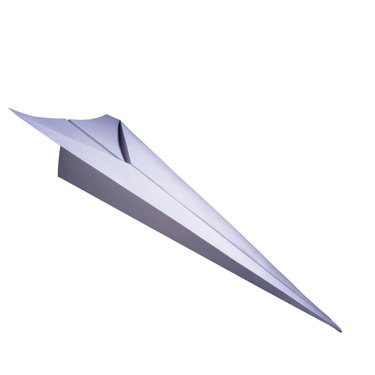
A successful paper airplane maintains stability during its flight and glides well over a distance. The size and shape of its wings, particularly the main wing, affects its performance. A lightweight plane with large wings glides well but travels slowly, while heavier planes with smaller wings travel more quickly and cover larger distances.
Main Wing
Video of the Day
Paper planes usually have one main wing. The main wing supports the plane while it is in the air, making it the most important part of the plane, according to the Yale-New Haven Teachers Institute. When designing a paper airplane, changing the size, shape, weight and smoothness of the wing will affect its speed, rate of descent and its ability to glide.
Video of the Day
Lift/Drag
Wind pressure acts against the wing of a paper plane in two directions. The vertical component of this force is called lift, while the horizontal component is called drag. A high ratio of lift to drag enables a plane to fly well. A plane's glide ratio, or the distance of its glide divided by its altitude, is equal to its lift ratio. A wing with a slight bend, or camber, to its shape will outperform a flat wing in terms of its lift/drag ratio. A smooth surface on a plane results in less air resistance, and thus less drag. Use the smoothest paper possible on your plane to reduce drag, which enables the plane to fly with less friction. This makes the plane fly faster than it would otherwise.
Wing Load
The wing loading of an airplane is the weight of the plane divided by the surface area of its main wing. Heavy planes with small wings have larger wing loads than light planes with large wings. A heavier wing load enables a plane to glide faster, which means it will also descend faster than a plane with a lighter wing load. To create a plane that glides long distances, design it with a light wing load. Build a plane with large wings and a lightweight body for optimal results. For a fast plane that travels long distances, design your plane with small wings like a dart.
Thickness
The thickness of the paper you use will influence your plane's lift. If your plane has a thick edge facing into the wind, it will prevent air from attaching to the wing. Air must attach to the wing for the plane to achieve lift. A thin leading edge allows air to attach to the plane's wing, which gives it lift and helps it glide. If the wing is too thick, it will fail to gain lift and fall easily.